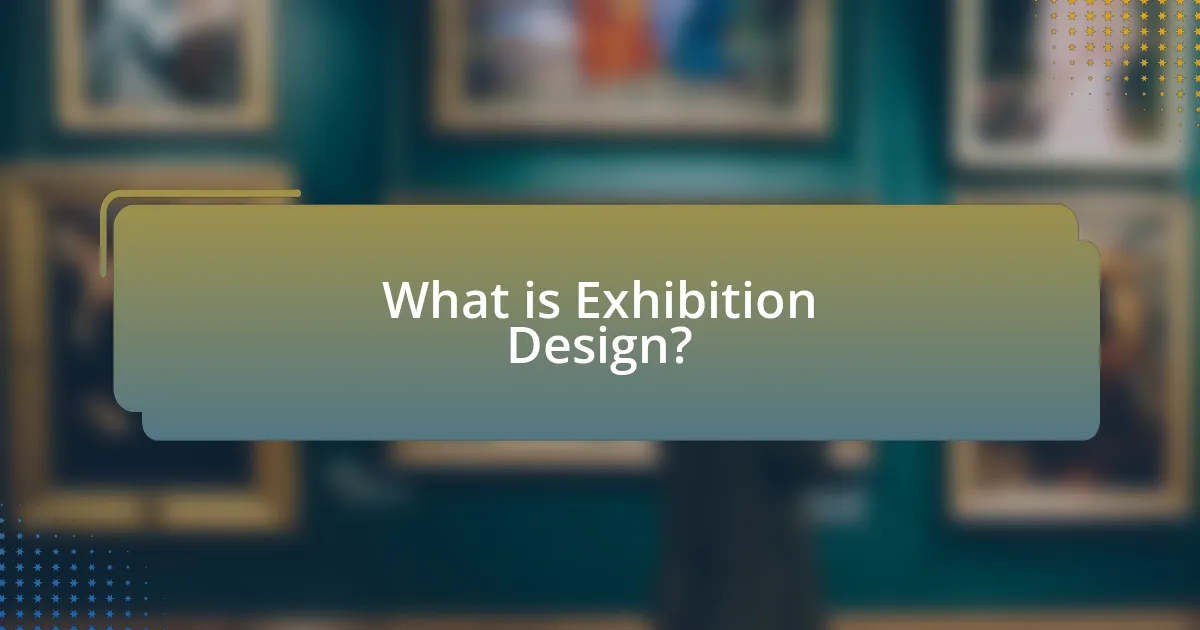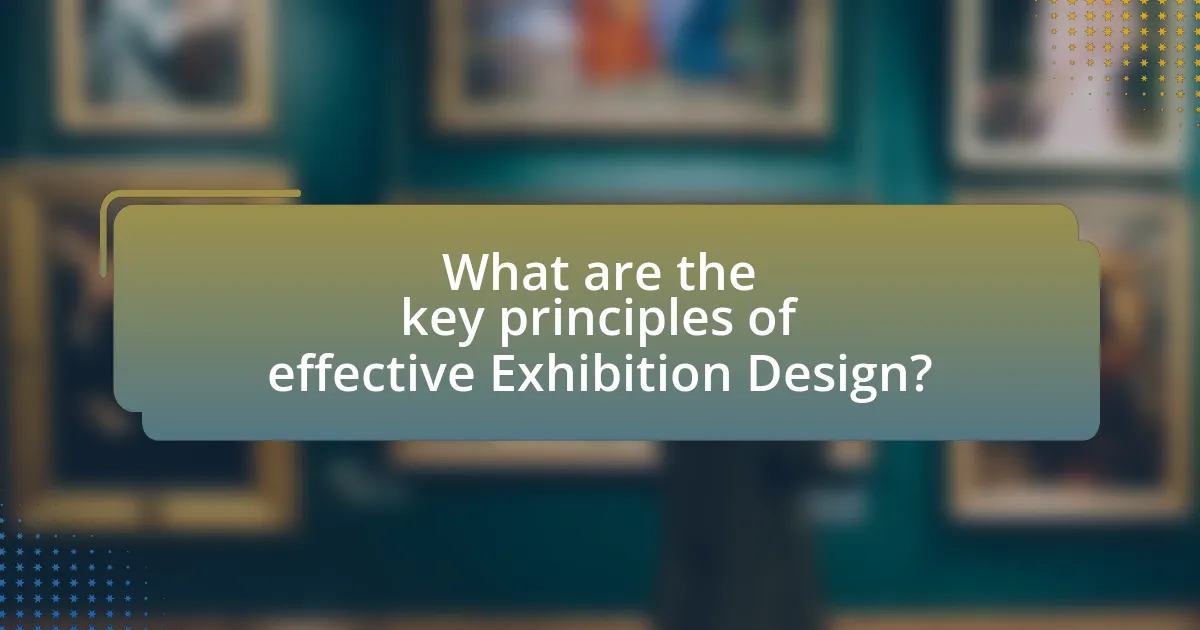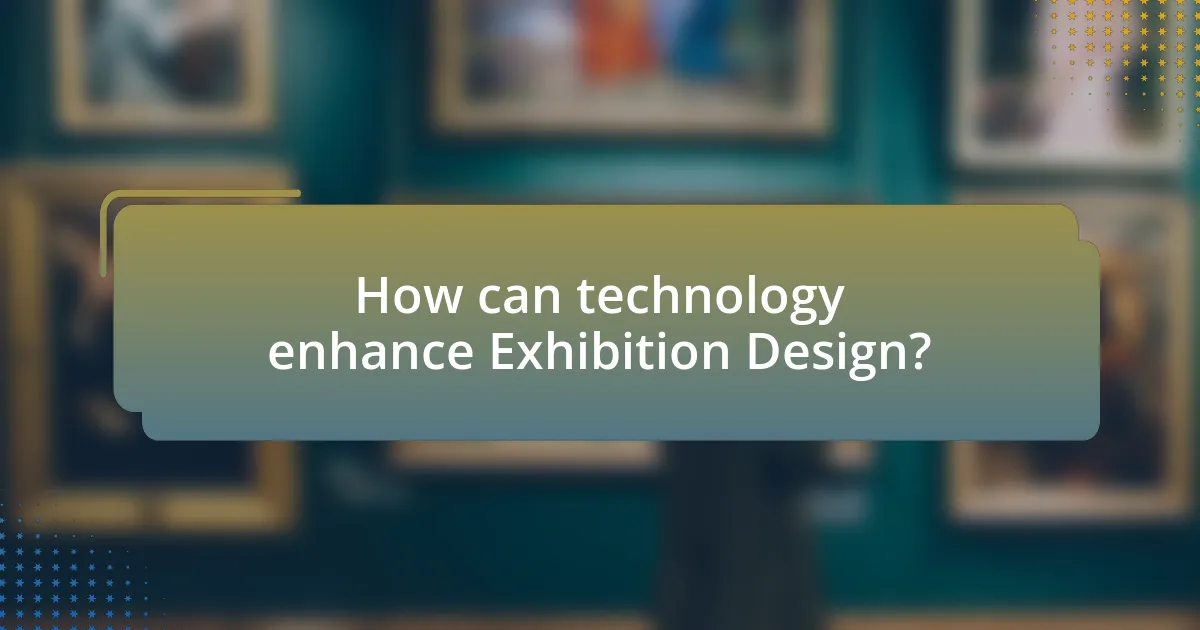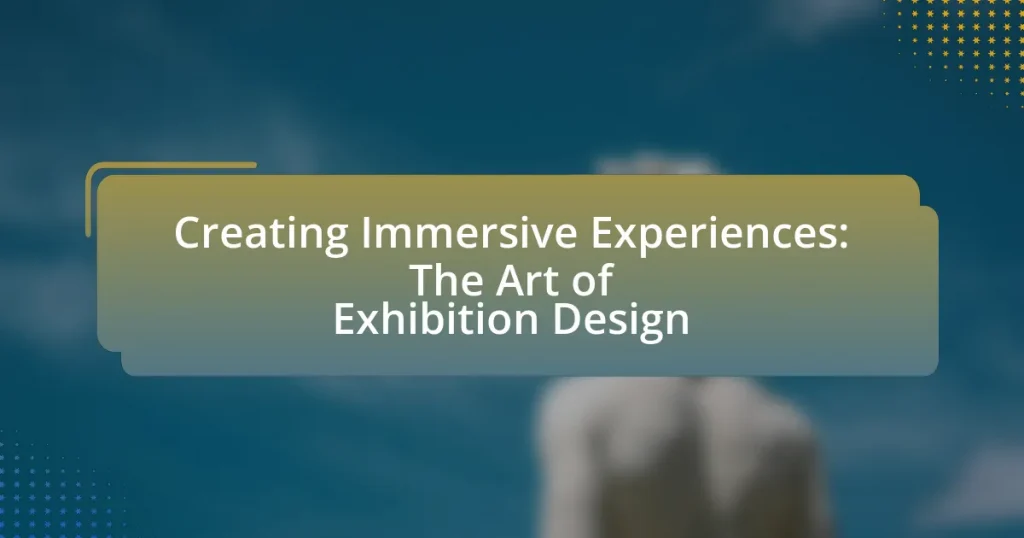Exhibition design is the discipline focused on creating engaging environments for displaying objects, ideas, or experiences, integrating architecture, graphic design, and storytelling to enhance visitor interaction. This article explores how effective exhibition design fosters immersive experiences through spatial organization, sensory engagement, and interactive elements, ultimately increasing visitor retention and satisfaction. Key principles such as clarity, accessibility, and narrative coherence are discussed, along with the impact of technology, including augmented and virtual reality, on enhancing engagement. The article also highlights best practices for integrating narratives and measuring the success of exhibitions, providing insights into the importance of feedback for continuous improvement in design.

What is Exhibition Design?
Exhibition design is the process of creating engaging and informative environments for displaying objects, ideas, or experiences to an audience. This discipline combines elements of architecture, graphic design, and storytelling to enhance visitor interaction and understanding. Effective exhibition design utilizes spatial organization, visual communication, and thematic coherence to guide visitors through the experience, ensuring that the intended message is conveyed clearly and memorably.
How does Exhibition Design create immersive experiences?
Exhibition design creates immersive experiences by integrating spatial design, interactive elements, and storytelling techniques. Spatial design involves the arrangement of physical space to guide visitors through a narrative, enhancing engagement. Interactive elements, such as touchscreens or virtual reality, allow visitors to participate actively, making the experience more memorable. Storytelling techniques weave a cohesive narrative that resonates emotionally with the audience, fostering a deeper connection to the exhibit. Research indicates that immersive environments can increase visitor retention and satisfaction, as evidenced by studies showing that interactive exhibits lead to higher engagement levels compared to traditional displays.
What elements contribute to an immersive exhibition environment?
An immersive exhibition environment is primarily created through the integration of sensory engagement, spatial design, narrative coherence, and interactive elements. Sensory engagement involves utilizing sound, light, and tactile experiences to captivate visitors, as evidenced by studies showing that multisensory experiences enhance memory retention and emotional connection. Spatial design refers to the layout and flow of the exhibition, which should facilitate exploration and discovery, supported by research indicating that well-organized spaces improve visitor satisfaction. Narrative coherence ensures that the exhibition tells a compelling story, guiding visitors through a cohesive experience, as demonstrated by successful exhibitions that effectively communicate their themes. Lastly, interactive elements, such as hands-on displays or digital interfaces, encourage active participation, which has been shown to increase visitor engagement and enjoyment. Together, these elements create a holistic and memorable exhibition experience.
How do sensory experiences enhance visitor engagement in exhibitions?
Sensory experiences enhance visitor engagement in exhibitions by creating immersive environments that stimulate multiple senses, leading to deeper emotional connections and increased retention of information. Research indicates that when visitors interact with exhibits through sight, sound, touch, taste, and smell, they are more likely to remember their experiences and share them with others. For instance, a study published in the Journal of Museum Education found that multisensory exhibits increased visitor satisfaction and engagement by 30% compared to traditional displays. This engagement is further supported by the fact that sensory stimuli can evoke memories and emotions, making the exhibition experience more memorable and impactful.
Why is Exhibition Design important in various industries?
Exhibition design is important in various industries because it enhances engagement and communication between brands and their audiences. Effective exhibition design creates immersive environments that attract visitors, convey messages clearly, and facilitate memorable experiences. For instance, in the trade show industry, well-designed exhibits can increase foot traffic by up to 50%, as reported by the Center for Exhibition Industry Research. This demonstrates that strategic design not only captures attention but also drives business outcomes by fostering connections and encouraging interaction.
What role does Exhibition Design play in museums and galleries?
Exhibition design plays a crucial role in museums and galleries by shaping the visitor experience through the strategic arrangement of artifacts, information, and space. This design discipline enhances engagement and understanding by creating immersive environments that facilitate storytelling and contextualization of exhibits. For instance, effective exhibition design can increase visitor retention and satisfaction, as evidenced by studies showing that well-designed spaces can lead to a 30% increase in visitor interaction with exhibits. By integrating visual elements, lighting, and spatial organization, exhibition design not only showcases collections but also influences how audiences perceive and connect with the content presented.
How does Exhibition Design impact trade shows and corporate events?
Exhibition design significantly impacts trade shows and corporate events by enhancing attendee engagement and brand visibility. Effective exhibition design creates immersive environments that attract visitors, facilitating meaningful interactions and experiences. According to a study by the Center for Exhibition Industry Research, 81% of attendees at trade shows reported that they were more likely to remember a brand that had an engaging booth design. This demonstrates that well-executed exhibition design not only draws in potential clients but also leaves a lasting impression, ultimately influencing purchasing decisions and brand loyalty.

What are the key principles of effective Exhibition Design?
The key principles of effective exhibition design include clarity, engagement, accessibility, and storytelling. Clarity ensures that the message is easily understood by the audience, which can be achieved through concise signage and intuitive layouts. Engagement involves creating interactive elements that invite participation, enhancing the visitor experience. Accessibility ensures that all visitors, regardless of physical ability, can navigate and enjoy the exhibition, often guided by universal design principles. Storytelling weaves a narrative throughout the exhibition, connecting various elements to create a cohesive experience that resonates with visitors. These principles are supported by research indicating that well-designed exhibitions can increase visitor retention and satisfaction, as evidenced by studies from the American Alliance of Museums.
How do storytelling techniques influence Exhibition Design?
Storytelling techniques significantly influence exhibition design by creating a narrative framework that guides the visitor’s experience. These techniques help to engage audiences emotionally and intellectually, making the exhibition more memorable. For instance, the use of thematic storytelling can organize exhibits in a way that unfolds a coherent narrative, allowing visitors to connect with the content on a deeper level. Research indicates that exhibitions designed with a clear narrative structure can increase visitor retention and satisfaction, as evidenced by studies showing that storytelling enhances learning outcomes in educational settings. This integration of storytelling into exhibition design not only captivates visitors but also facilitates a more profound understanding of the subject matter presented.
What are the best practices for integrating narratives into exhibitions?
The best practices for integrating narratives into exhibitions include creating a cohesive storyline, utilizing diverse media, and engaging the audience emotionally. A cohesive storyline ensures that all elements of the exhibition work together to convey a clear message, enhancing visitor understanding and retention. Utilizing diverse media, such as text, audio, video, and interactive displays, caters to different learning styles and keeps the audience engaged. Engaging the audience emotionally through relatable stories or immersive experiences fosters a deeper connection to the content. Research indicates that exhibitions with strong narratives can increase visitor satisfaction and retention of information, as evidenced by studies conducted by the American Alliance of Museums, which highlight the importance of storytelling in enhancing educational outcomes in museum settings.
How can designers ensure a cohesive story throughout the exhibition space?
Designers can ensure a cohesive story throughout the exhibition space by establishing a clear narrative framework that guides the design elements and visitor experience. This involves integrating thematic visuals, consistent signage, and a logical flow of exhibits that align with the overarching story. For instance, the use of color schemes, materials, and lighting can reinforce the narrative, creating an immersive environment that resonates with visitors. Research indicates that cohesive storytelling in exhibitions enhances visitor engagement and retention of information, as evidenced by studies showing that well-structured narratives can increase visitor satisfaction by up to 30%.
What design elements are crucial for creating immersive experiences?
Crucial design elements for creating immersive experiences include spatial design, sensory engagement, narrative structure, and interactivity. Spatial design involves the layout and flow of the environment, which can influence how users navigate and perceive the space. Sensory engagement incorporates visual, auditory, tactile, and olfactory elements to stimulate the senses and enhance emotional connections. Narrative structure provides a storyline or theme that guides the experience, making it more relatable and memorable. Interactivity allows participants to engage actively with the environment, fostering a sense of agency and personal investment in the experience. These elements collectively contribute to a cohesive and impactful immersive experience, as evidenced by successful exhibitions that prioritize user engagement and emotional resonance.
How do lighting and color schemes affect visitor perception?
Lighting and color schemes significantly influence visitor perception by shaping emotional responses and guiding attention. Research indicates that warm lighting and vibrant colors can evoke feelings of comfort and excitement, while cooler tones and dim lighting may create a sense of calm or seriousness. For instance, a study published in the Journal of Environmental Psychology found that environments with warm lighting and bright colors increased visitor engagement and satisfaction by 20% compared to those with neutral or cold lighting. This demonstrates that strategic use of lighting and color can enhance the overall experience, making exhibitions more memorable and impactful.
What role does spatial layout play in guiding visitor flow?
Spatial layout plays a crucial role in guiding visitor flow by strategically organizing spaces to enhance navigation and engagement. Effective spatial design utilizes pathways, sightlines, and zoning to direct visitors through an exhibition, ensuring they experience key exhibits while minimizing congestion. Research indicates that well-planned layouts can increase visitor satisfaction and dwell time; for instance, a study published in the Journal of Visitor Studies found that exhibitions with clear pathways resulted in a 30% increase in visitor engagement compared to poorly organized spaces.

How can technology enhance Exhibition Design?
Technology enhances exhibition design by enabling interactive and immersive experiences that engage visitors more effectively. For instance, augmented reality (AR) and virtual reality (VR) allow attendees to interact with exhibits in a dynamic way, providing deeper insights and emotional connections to the content. According to a study by the International Association of Exhibitions and Events, 70% of attendees reported that interactive elements significantly improved their overall experience at exhibitions. Additionally, digital displays and projection mapping can transform static exhibits into captivating visual narratives, making information more accessible and memorable. These technological advancements not only attract larger audiences but also foster a more meaningful engagement with the subject matter presented.
What types of technology are commonly used in exhibitions?
Commonly used technologies in exhibitions include interactive displays, augmented reality (AR), virtual reality (VR), projection mapping, and digital signage. Interactive displays engage visitors through touchscreens or motion sensors, enhancing participation. Augmented reality overlays digital information onto the physical environment, allowing for enriched storytelling. Virtual reality immerses users in a fully digital environment, creating unique experiences. Projection mapping transforms surfaces into dynamic displays, captivating audiences with visual storytelling. Digital signage provides real-time information and updates, improving visitor navigation and engagement. These technologies collectively enhance the immersive experience of exhibitions, making them more engaging and informative.
How do interactive displays engage visitors more effectively?
Interactive displays engage visitors more effectively by facilitating active participation and enhancing sensory experiences. These displays allow users to interact with content through touch, movement, or voice, which increases engagement levels compared to passive viewing. Research indicates that interactive elements can boost retention rates by up to 70%, as they encourage visitors to explore and learn at their own pace. Additionally, studies show that immersive technologies, such as augmented reality, can create memorable experiences that foster emotional connections, further enhancing visitor engagement.
What are the benefits of using augmented and virtual reality in exhibitions?
The benefits of using augmented and virtual reality in exhibitions include enhanced engagement, improved learning experiences, and increased accessibility. Augmented reality (AR) allows visitors to interact with digital content overlaid on the physical environment, making exhibits more engaging and informative. For instance, a study by the University of Illinois found that AR can increase visitor retention of information by up to 70%. Virtual reality (VR) immerses users in a fully digital environment, enabling them to experience scenarios that may be impossible in real life, such as historical events or distant locations. This immersive experience can lead to deeper emotional connections and understanding of the subject matter. Additionally, both AR and VR can make exhibitions more accessible to individuals with disabilities, providing alternative ways to experience content. According to a report by the International Journal of Human-Computer Interaction, 85% of users found VR experiences to be more inclusive than traditional exhibitions.
How can designers measure the success of an exhibition?
Designers can measure the success of an exhibition through visitor engagement metrics, feedback surveys, and sales data. Visitor engagement can be quantified by tracking attendance numbers, the duration of visits, and interactions with exhibits, which provide insights into how well the exhibition captures interest. Feedback surveys collected from attendees can reveal perceptions of the exhibition’s effectiveness, including aspects such as design, content, and overall experience. Additionally, sales data, if applicable, can indicate the commercial success of the exhibition, reflecting how well it meets the objectives of the designers and stakeholders involved. These methods collectively offer a comprehensive view of an exhibition’s impact and effectiveness.
What metrics are used to evaluate visitor engagement and satisfaction?
Visitor engagement and satisfaction are evaluated using metrics such as dwell time, visitor feedback, Net Promoter Score (NPS), and repeat visitation rates. Dwell time measures how long visitors spend at an exhibition, indicating their level of interest and engagement. Visitor feedback, collected through surveys or comment cards, provides direct insights into their experiences and satisfaction levels. The Net Promoter Score quantifies the likelihood of visitors recommending the exhibition to others, reflecting overall satisfaction. Repeat visitation rates indicate how many visitors return, suggesting a positive experience that encourages them to come back. These metrics collectively provide a comprehensive understanding of visitor engagement and satisfaction in exhibition design.
How can feedback be utilized to improve future exhibitions?
Feedback can be utilized to improve future exhibitions by systematically collecting and analyzing visitor responses to identify strengths and weaknesses in the exhibition design. For instance, post-exhibition surveys can reveal visitor satisfaction levels, highlight areas for enhancement, and provide insights into visitor engagement with the exhibits. Research indicates that 70% of organizations that actively seek feedback report improved visitor experiences in subsequent events. By implementing changes based on this feedback, such as adjusting layout, enhancing interactivity, or refining content, exhibition designers can create more immersive and engaging experiences that resonate with audiences.
What are some best practices for creating immersive exhibition experiences?
To create immersive exhibition experiences, designers should prioritize interactivity, sensory engagement, and narrative coherence. Interactivity allows visitors to actively participate, enhancing their connection to the content; for instance, touchscreens or hands-on displays can significantly increase engagement levels. Sensory engagement involves incorporating visual, auditory, and tactile elements that stimulate multiple senses, which has been shown to improve memory retention and emotional response. For example, using ambient soundscapes or scent can create a more enveloping atmosphere. Narrative coherence ensures that the exhibition tells a compelling story, guiding visitors through a cohesive experience that resonates emotionally. Research indicates that exhibitions with a strong narrative framework can increase visitor satisfaction and retention of information.
How can designers balance creativity with practical constraints?
Designers can balance creativity with practical constraints by employing a structured design process that integrates innovative ideas with feasibility assessments. This approach involves brainstorming creative concepts while simultaneously evaluating material costs, time limitations, and technical requirements. For instance, a study by the Design Management Institute found that companies that effectively combine creativity with practical considerations see a 10% increase in project success rates. By utilizing tools such as prototyping and iterative feedback, designers can refine their ideas to meet both aesthetic goals and practical needs, ensuring that the final design is both imaginative and executable.
What tips can help ensure a successful exhibition design process?
To ensure a successful exhibition design process, it is essential to establish clear objectives and a cohesive theme. Defining the goals of the exhibition guides the design decisions and ensures that all elements align with the intended message. Research indicates that a well-defined theme can enhance visitor engagement and retention, as seen in successful exhibitions like the “Van Gogh Experience,” which effectively used a cohesive narrative to draw in audiences. Additionally, involving stakeholders early in the design process fosters collaboration and ensures that diverse perspectives are considered, leading to a more inclusive and effective design.















